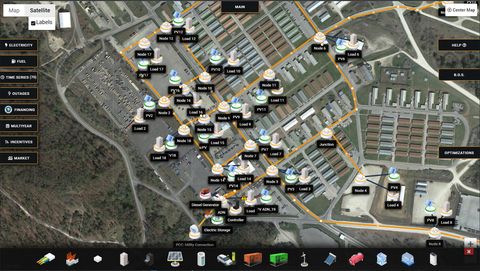Local Energy Systems Planning for Communities
Climate-resilient local energy infrastructure is on the agenda in every Boardroom ( and indeed, around every dinner table )
Even though onsite energy generation offers a wealth of benefits, it also requires a great deal more planning, engineering and maintenance than a simple grid connection.
Local Energy Systems are made further complicated by the fact that the constituent energy sources ( the microgrids ) must be designed to fit the load profile of the community buildings, the local weather conditions, and to meet the specific needs of the facility—be it a single office building or an entire community.
Energy Flexibility, Efficiency, Cost, and Resilience
To help meet all these engineering challenges, particularly in larger projects, we will use the Xendee MicroGrid Decision Support Platform to model multiple scenarios. Xendee's Techno-Economic Modelling is the key to devising an investor-friendly proposal that can be used to raise finance - modelling can optimise both carbon and energy costs at the same time.
Xendee's multi-node capability that enables users to create advanced, interconnected microgrid networks from a constellation of smaller microgrids or DERs that can support up to 25 technology types, including solar PV, battery storage, hydrogen, hydrokinetic and more. The multi-node feature enables the use of multiple nodes (a bus bar where multiple technologies or loads can be circuited together) and uses real-world location data of each node to optimise the final design and investment strategy. This allows for a more realistic model of communities or campuses, and allows energy to be generated, used, and transferred most efficiently.

For further information, don't hesitate to get in touch with us.
Local Energy Systems = Community MicroGrids = Smart Local Energy Systems ( So many names, but all the same technology and results )
Quotes from the UK Energy Research Centre Briefing - September 2022
Institutional Landscapes for Local Energy Systems: Mapping England, Scotland and Wales
" Local Energy Systems are expected to deliver whole system benefits in the form of flexibility, resilience and efficiencies in supply and use, as well as supporting place-based socio-economic priorities such as jobs, air quality and lower energy bills (Energy Systems Catapult ) "
" Local integration could also encompass new business structures, including local ownership and equity shares, and more participative democratic control including local and regional government roles. Much activity to date has focussed on high level policy statements (see for example BEIS 2021; Scottish Government 2021) and allocation of innovation funding for LES ‘experiments’. There is, however, no consistent policy framework or regulatory strategy to support LES developments across Great Britain, and emerging evidence suggests there are differing policy approaches across England, Scotland and Wales "
The most significant advantage of MicroGrid Modelling is the ability to test the broadest range of scenarios - be they future policy, new technologies, or alternative business models.
MicroGrid Modelling
The greatest advantage of MicroGrid Modelling is the ability to test the widest range of scenarios - be they future policy, new technologies, or alternative business models.
